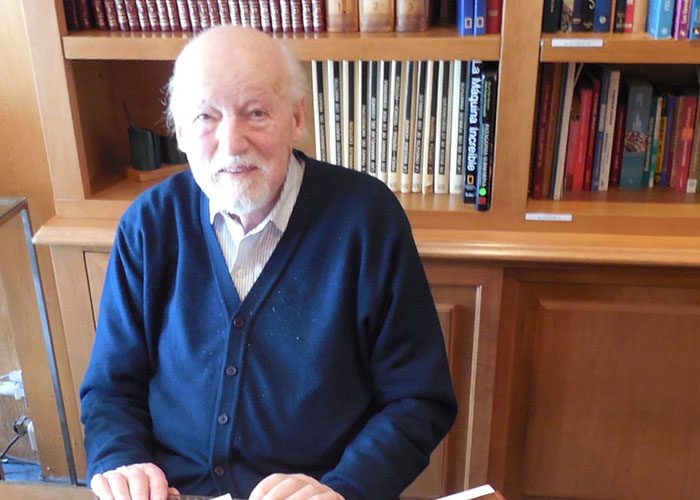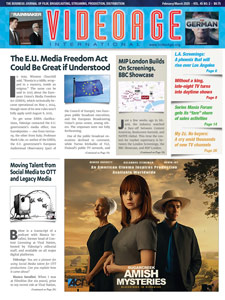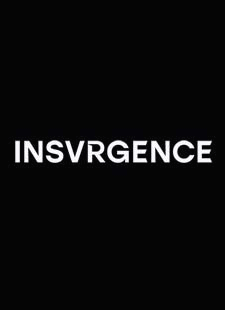Pedro Simoncini has been involved with Canal 11 in Buenos Aires since 1957. He developed it into Telefe in 1989.
His story is rich in drama (military takeovers), financial intrigue (making 120 investors agree on a strategy), international diplomacy (ABC-TV’s involvement), religious harmony (a Jesuit-owned station vs. Jewish-owned stations), historical decisions (picking the color-TV standard), and politics (dealing with Evita Perón).
Simoncini is known internationally — especially in the U.S. and Argentina — as a broadcasting pioneer. However, his initial ambition was simply to produce and distribute educational TV programs, which he started doing in 1978 in Buenos Aires with Programas Santa Clara. That was around the same time that he started attending MIP-TV, bringing along his little daughter, Karin.
Earlier, in 1964, Simoncini was among the first broadcasters to attend what are now called the L.A. Screenings.
In those years, 1974-1980 specifically, Simoncini also served as president of the Asociación de Teleradiodifusoras Argentinas, representing the interests of his own TV station, Canal 5, in the city of Rosario (even though his “magic” number has always been 11, as in Teleonce), and later, Telefe. But let’s first proceed with a prequel.
When “Pietro” Simoncini left his native Naples, Italy, for Argentina in 1924, he was just one year old. His parents decided to return to Naples the following year, but later went back to Argentina, permanently settling in Buenos Aires in 1927. Yet Pietro didn’t become an Argentine citizen until 1940 because, as he said, “My parents insisted on remaining Italian. They returned to Naples in 1925 so that they could give birth to my brother in Italy.”
At first, it seemed unlikely that fate would lead him to become a pioneer of Argentine TV, succeeding in bringing local TV stations together and creating Telefe — one of the two main TV networks in Argentina — in 1989. But that’s exactly what happened.
Let’s now jump forward a few years to 1943, to find Pietro, now known as Pedro, employed by Banco Italiano in Buenos Aires and tasked with paying a salary to actress and radio personality Eva Duarte (the future Evita Perón) on behalf of Bulgarian immigrant Jaime Yankelevich (1896-1952), owner of Radio Belgrano. “She would come to my office and I’d authenticate her signature in order for her to collect her salary,” Simoncini remembered of Evita.
VideoAge met Simoncini last September at his office, which is located on Avenida Belgrano. “Nowadays, I come to the office just in the mornings, and am always accompanied because I feel unwell, and since last year, I can no longer drive. I never imagined that being old was so hard,” he confessed.
Now Simoncini is solely dedicated to the development of educational content, “which has always been my passion,” he said. He retired from the commercial TV sector in 1993 to focus on the production of educational programs, and is still an active member of the Academia Nacional de Educación.
In the 1940s, Simoncini also took care of the finances and investments of the Order of the Jesuits (Companía de Jesus), which in 1957 decided to apply for a government license to operate a television station. The Jesuit leader, Héctor N. Grandinetti of Colegio del Salvador, gathered 120 investors to form the Difusora Contemporánea (DiCon) company, and requested authorization for Canal 11 (one of the seven frequencies made available for the then-nascent private TV sector set up to compete with the state national network, Canal 7) to start up three channels in Buenos Aires and two in Córdoba and Mendoza.
Regular TV broadcast in Argentina had begun in 1951 with Canal 7, which was developed by Radio Belgrano’s Yankelevich (and sponsored by the then de facto-ruling Evita Perón). After the 1955 military coup (Revolución Libertadora) that sent President Juan Perón into exile, Canal 7 became (and is to this day) a government TV station.
Canal 7 was renamed Argentina Televisora Color (ATC) in 1979 after it provided the international TV feed in color for the 1978 football (soccer) World Cup held in Argentina. However, ATC broadcast only one match in color. Regular color broadcasts didn’t begin until 1980, and used a modified PAL standard.
A debate was held to select the color-television standard, but against the advice of technicians, a hybrid German-made PAL system was chosen over the American NTSC. A modified PAL standard was selected because of pressure from the Cámara de Industria de Artículos Electrónicos en la Argentina (CADIE), which didn’t want color TV sets imported from Germany or the U.S. All TV stations later adopted the same standard.
Following the 1958 democratic elections, President Arturo Frondizi opened to private TV channels, a process that was begun two years earlier by then-president Pedro Aramburu of Revolución Libertadora.
Simoncini was tasked with maintaining harmony among all the Canal 11 investors, who, he remembered, “saw the channel mainly as the call to fame for their wives and children.” In effect, Simoncini became the first general manager of the station, but, due to internal bickering, Canal 11 was the last of the three Buenos Aires stations to go on the air. It did so in 1961 and was branded as Teleonce.
Short on funds, Canal 11 had to find other investors to finance programming, and knowing that the U.S. TV networks were looking for investments in South America, Simoncini approached the only American TV network left without a local partnership: ABC. CBS was already allied with Canal 13 and Ricardo Pueyrredón, who partnered with Goar Mestre, (the channel was later rebranded as Artear and became part of the Clarin Publishing Group). NBC was partnered with Canal 9 and Ildefonso Recalde, who took it over from German immigrant Kurt Lowe.
“It was the only way to compete with the TV station of the Cuban transplanted in Argentina, Goar Mestre [1912-1994],” said Simoncini of his rival and fellow pioneer of Argentine TV.
However, because the Argentine government did not allow foreign companies to enter as TV station shareholders, DiCon and ABC created Telerama, an external company for programming and advertising. Similar gimmicks were undertaken by Canal 13 and CBS with Proartel, and Canal 9 and NBC with Telecenter.
For example, in the case of Proartel, when ad agencies were billed for airtime, they received two invoices: one from Proartel, the other from Rio de la Plata, which was the licensee of Canal 13. Mestre was still a Cuban citizen, so he could only control Proartel.
Similarly, Michael J. Solomon, at the time a content sales executive at MCA-Universal, remembered that all billings for content acquisitions for Canal 11 would go to Telerama, which, confirmed Simoncini, was 90 percent owned by ABC.
At this point a social factor contributed to Simoncini’s career path. The Jesuits felt intimidated by the fact that both Canal 9 and Canal 13, owned by Argentinean Jews, partnered with the U.S. TV networks, which were started by American Jews, and that the only partner left was the Jewish ABC.
Recalled Pedro Leda of Ledafilms Distribution: “For logical reasons, negotiations were very delicate and a good diplomat was needed. The Jesuits sent their legal counsel, Pedro Simoncini, to New York City. Both parties were so impressed by how well Simoncini handled the negotiations that they agreed to [officially] appoint him general manager of Canal 11.”
It also helped that Simoncini spoke English (which he had learned at school) and that he was a good lawyer, who was versatile with negotiations. He also speaks Spanish, “some French,” and perfect Italian without a Neapolitan accent, because, he said, “My mother was from Tuscany and we spoke good Italian at home.”
Leda continued: “Canal 11 was not the number one channel in Buenos Aires, but [it was] the most profitable because it limited operational costs. Its programming was essentially based on ABC series and movies, plus local news and talk shows, and drama series. Telenovelas were not a dominant genre at the time.”
In 1970, a combination of factors, including the change of management at ABC International (which went from Don W. Coyle to Dick O’Leary), to the renewed political instability in Argentina (with three different presidents from June 1970 to March 1971), led to Canal 11 being sold to Héctor R. García’s Editorial Sarmiento. Simoncini moved on to other ventures. (ABC had started the international division under Coyle in 1958.)
The ABC link allowed Simoncini, and other Latin American broadcasters, to enter the L.A. Screenings in 1964 when Michael J. Solomon — who had just joined MCA (now NBCUniversal) approached Jack Singer in New York City. Singer was responsible for programming the many TV stations that ABC controlled overseas and reported to Coyle. Solomon asked Singer if he could invite the managers of the 10 or so TV stations that ABC managed in Latin America to MCA Studios in Los Angeles to screen and buy the new shows that MCA was producing, mainly for ABC.
In 1973, all three Buenos Aires channels and a few channels in the interiors were nationalized by the time Juan Perón returned as president for the third time. The owners were compensated by the military, which had ruled just before Peron.
With the return of the military dictatorship (Proceso de Reorganización Nacional) in 1976, Canal 13 was put under the control of the Navy, Canal 9 went to the Army, and Canal 11 was assigned to the Air Force.
Recalled Leda: “[Members of the military] were at the stations mostly in civilian clothes, but occasionally also in uniform. Each of the three channels had a civilian manager in charge of production, acquisitions, programming and scheduling — men with previous TV experience who reported to the military interventores. And in turn, the interventores reported to a higher radio and television entity also run by the military.”
In 1977, the U.S. broadcasting, producing and distribution company Metromedia appointed Simoncini as program sales representative for Argentina, Paraguay and Uruguay.
Explained Paul Rich: “Pedro was Metromedia Producers’ rep in Argentina for the years when I headed the company (1982-85). Among all the sales reps we had around the world at the time — 12 in all — he was a gentle soul, a fierce negotiator and a keen student of our business, totally loyal. He reminded me so much of my father, who, like Pedro, carried himself with the same self-assurance and yet [had an] approachable, lovable style.
“Our relationship ranged way beyond television and selling; it embraced politics, religion, culture, and education. He was totally immersed not only in what was happening in South America but very much in what was going on in the U.S. on all levels.”
With the return of democracy in 1983, President Raúl Alfonsín licensed Canal 9 back to its former owner, Alejandro Romay, in 1984. Canal 11 and Canal 13 both remained government-owned until 1989. When the next president, Carlos Menem, re-privatized the TV stations, Canal 13 went to Clarin and Canal 11 went to Editorial Atlántida (in 1971, Atlántida had acquired Canal 13, which was nationalized two years later). Clarin bid for both Canal 11 and 13, but having to select one, chose 13.
Meanwhile, in 1972, Simoncini became a shareholder, and in 1975, the majority shareholder (70 percent) and president of Rosario’s Canal 5, and a minority shareholder at other TV stations in Córdoba, Resistencia and Neuquén. Those channels, recalled Simoncini, were not nationalized. Canal 5 was founded in Rosario, the country’s third largest city, in 1964, to rebroadcast the TV programs from Buenos Aires of the state-owned Canal 7.
Commented Pedro Leda: “Simoncini recognized the importance of creating a TV network that included newly licensed free-TV channels in the interior and successfully pursued agreements with local broadcasters in several cities of Argentina. These agreements allowed the local TV stations to compete in their markets by receiving the Canal 11 programing and know-how.”
In 1989, he grouped Canal 5 and others in which he had investments with Canal 11 in Buenos Aires (just privatized — the government had appropriated it in 1974) to form Television Federal S.A., or Telefe, which, Simoncini explained, “did not denote Tele Fede (Faith) or a Catholic TV station (since Canal 11 had always been associated with the Jesuits), but federal television, as it covered much of the country. Nonetheless, our slogan was ‘El Canal de la Familia.’”
At that time Telefe had as its main stockholders the partners of Televisoras Provinciales (with 30 percent), including: Canal 8, Mar del Plata; Canal 8, Tucumán; Canal 9, Bahía Blanca; Canal 11, Salta; Canal 13, Santa Fe; Simoncini’s own Canal 5, Rosario; Canal 8, Córdoba and Canal 7, Neuquén. Editorial Atlántida had 14 percent.
Simoncini was the head of Televisoras Provinciales and controlled his own TV interests through Rader, a company that in 1998 was acquired by Compañia de Television del Atlántico.
On the phone, Simoncini recalled that the affiliates could have been 10 TV stations and that all paid to carry programs from Canal 11 in Buenos Aires, which was branded as Telefe. The affiliates, in turn, would make money by filling spots left in the programs with local commercials.
The affiliates rebroadcast Canal 11 of Buenos Aires with delayed content, at times even with a week’s delay (with the exception of news programs, which were simulcast).
In effect, 29 years after creating harmony among the 120 investors of Canal 11 in Buenos Aires, Simoncini returned to Canal 11 with the task of putting together a similar number of partners to create Telefe with Canal 11 in Buenos Aires as the flagship station.
With Simoncini leading the way, Telefe began producing television series, including telenovelas, and exporting them to Uruguay (Canal 4 and Canal 12). He “retired” in 1993, and five years later the network was sold to Spain’s Telefonica. Today, Telefe is owned by Viacom.
At that time (and still today), Telefe owned and operated nine local TV stations, plus it continues to have nine affiliates that help to reach 95 percent of the country’s TVHH, and all remaining TV homes via cable TV and satellite.
Simoncini “retired,” but only from the commercial sector, because, in 1992, he founded TV Quality, a production company for educational programs, thereby returning to his first love. In 1994, this complemented another of his creations, Educable, which distributes cultural and educational programs to various cable TV channels in agreement with the Asociación Argentina de TV por Cable.
According to Simoncini, “the difference between cultural and educational programs is that ‘cultural’ includes educational elements, while ‘educational’ is just a teaching tool.”
Just before leaving Telefe, Simoncini became president of Fundación Compromiso, an association of not-for-profit companies, a position he held up until the year 2000.
Simoncini’s only child, Karin, began her TV career just after college in 1992 at Teleinterior, a content distribution company, and two years later she joined her father at TV Quality. In 2000, she went to work at National Geographic in Washington, D.C., and in 2010 to Australia for FOX Channels. Since 2014, she has been at ZooMoo Networks as head of Programming.
Of those years with her father, Karin remembered, “He was a tough boss, but an inspiring one. What I most admired in him was that he was such a lateral thinker.”
(By Dom Serafini)
Audio Version (a DV Works service)












Leave A Comment